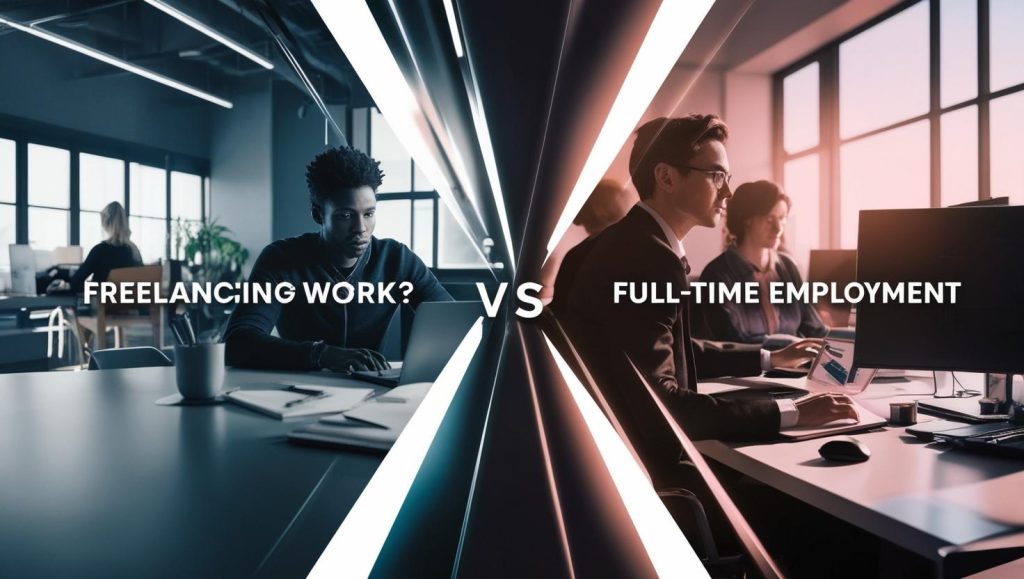
Choosing between life as a full-time freelancer or a full-time employee is one of the most pivotal career decisions you’ll face. Each path offers distinct advantages and challenges, and the “better” option depends on your priorities—freedom, stability, growth, or balance. Whether you’re eyeing the flexibility of freelancing or the security of a steady paycheck, this comparison will help you weigh the pros and cons to find the best fit for your goals.
1. Freedom and Flexibility: Freelancer’s Dream, Employee’s Constraint
Freelancer: As a freelancer, you’re the boss of your schedule. Want to work from a beach in Bali or take a random Wednesday off? You can. You choose your clients, projects, and hours, tailoring your work to your lifestyle. This autonomy is a game-changer for those who value freedom over routine.
Employee: Full-time employees typically trade flexibility for structure. A 9-to-5 schedule, office commutes, and fixed vacation days can feel restrictive, especially if your employer enforces rigid policies. However, some companies now offer remote work or flexible hours, narrowing the gap slightly.
Who Wins? Freelancers take the crown for flexibility, but if you thrive in routine, an employee role might feel more comfortable.
2. Income Potential: Sky’s the Limit or Steady Paycheck?
Freelancer: Your earning potential is uncapped. Skilled freelancers in fields like web development or design can charge premium rates, especially with platforms like Joomla streamlining their workflow (as explored in our previous post). However, income can be inconsistent—feast-or-famine cycles are real, and you’re responsible for finding clients.
Employee: A full-time job offers predictable pay, often with bonuses, raises, and benefits like health insurance or retirement plans. While your salary may grow over time, it’s typically capped by your role or industry standards, limiting your ability to scale earnings quickly.
Who Wins? Freelancers have higher earning potential but face volatility. Employees get stability but sacrifice upside.
3. Job Security and Benefits: Safety Net vs. Hustle
Freelancer: Freelancing comes with no safety net. There’s no paid leave, health insurance, or unemployment benefits unless you arrange them yourself. You’re also vulnerable to client turnover or market shifts, which can disrupt your income. On the flip side, diversifying clients can mitigate some risks.
Employee: Full-time employees enjoy a stronger safety net. Paid time off, health coverage, and retirement contributions are standard in many roles. Layoffs are a risk, but severance packages or unemployment benefits often soften the blow. For those prioritizing security, this is a major draw.
Who Wins? Employees win for stability and benefits, but freelancers can build their own safety nets with planning.
4. Skill Growth and Career Development
Freelancer: Freelancers wear many hats—marketer, accountant, designer, and more. This forces you to learn fast and stay versatile. Working on diverse projects (like building Joomla-powered sites) sharpens your skills and keeps your portfolio fresh. However, you’re on your own for training and networking.
Employee: Employees often get access to company-sponsored training, mentorship, and clear career paths. You might specialize in a niche role, gaining deep expertise. But corporate environments can stifle creativity or pigeonhole you into repetitive tasks, especially in larger firms.
Who Wins? Freelancers gain broader skills; employees get structured growth. It depends on whether you want variety or specialization.
5. Work-Life Balance: Control vs. Predictability
Freelancer: You control your workload, but that can be a double-edged sword. Overcommitting to clients can lead to burnout, while slow periods might leave you anxious. Setting boundaries is key to balancing work and life, but it’s entirely on you to enforce them.
Employee: A fixed schedule can make work-life balance easier to predict, but it’s not always better. Overtime, office politics, or demanding bosses can encroach on personal time. Still, “leaving work at work” is often easier when you’re not the one running the show.
Who Wins? It’s a toss-up—freelancers have more control, but employees may find balance easier with clear boundaries.
6. Passion and Purpose: Following Your Path
Freelancer: Freelancing lets you chase projects that spark joy. Love building sleek Joomla sites? You can focus on that and ditch the rest. This freedom to align work with passion is a huge motivator, though it comes with the pressure of staying marketable.
Employee: Full-time roles can align with your passions, but you’re often tied to a company’s goals. If your job feels misaligned, it’s harder to pivot without leaving. That said, some find purpose in team collaboration or contributing to a larger mission.
Who Wins? Freelancers have an edge for pursuing passion projects, but employees can find meaning in stable, purpose-driven roles.
The Verdict: Which is Better?
There’s no universal winner—it’s about what you value most. If you crave freedom, variety, and unlimited earning potential, freelancing could be your path. Platforms like Joomla make it easier than ever to deliver standout work and attract clients. But if stability, benefits, and structure matter more, a full-time employee role offers peace of mind.
Pro Tip: Test the waters. Try freelancing part-time while employed to see if it suits you before diving in. Whichever you choose, align it with your goals, and you’ll thrive.
What’s your take—freelancing or full-time? Share your thoughts below!






